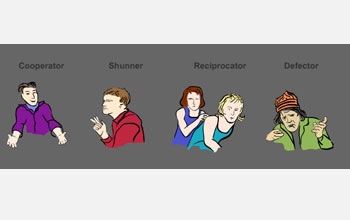|

Discovery
Why Contribute to the Good of the Group?

Are you more likely to help someone who has helped out on community projects?
December 17, 2004
Would you refuse to house-sit for a vacationing neighbor if you knew that she never participates in the local PTA or neighborhood watch program? If so, according to a study funded by the National Science Foundation, you may be partly responsible for maintaining social order in your community.
The question addressed in the study is as follows: why do people engage in collective actions – behaviors for which an individual pays a cost to provide a benefit to the whole group – rather than simply freeload on the actions of others? Examples of collective actions range from villagers draining a swamp to limit disease to US citizens paying income taxes to provide for the national defense.
“If the help and support of a community significantly affects the well-being of its members, then the threat of withdrawing that support can keep people in line and maintain social order,” said Karthik Panchanathan, a UCLA graduate student and first author of the report. “Our study offers an explanation of why people tend to contribute to the public good. Those who do will be supported by other community members and thus outcompete freeloaders.”
As shown in the interactive illustration, Panchanathan and anthropologist Robert Boyd modeled four strategies that people might use in large-scale societal cooperation. The model has two stages: collective action and mutual aid. In collective action, individuals work for the good of the group, for example, helping to drain a swamp. In mutual aid, individuals help others in order to be included in future cooperation, for example, in helping neighbors with home repairs. Those who contribute to collective action gain good standing, and this good standing may influence others to help them in the mutual aid phase.
A “Cooperator,” who will help the community drain a swamp AND help anybody with repairs, is using a strategy that will be eliminated by any of the other strategies. Nice guys finish last in this game.
A “Defector” won’t help the community drain a swamp AND refuses to help anyone with repairs.
A “Reciprocator” won’t help drain the swamp AND helps only those who have helped others with repairs – that is, he does not base his decision to help others on whether they helped drain the swamp.
A “Shunner” will help drain the swamp AND help others with repairs only if the others also helped drain the swamp. The Shunner is the guy whose strategy links action for the public good to whether or not a person gets aid.
Over time, a society tends to become made up of Defectors, Reciprocators, or Shunners. While Shunners can invade Defectors if the conditions are right, the opposite is not true. While Reciprocators and Shunners cannot invade the other, a number of selection processes can account for a transition from pure reciprocity (Reciprocators) to linked indirect reciprocity and collective action (Shunners).
-- Elizabeth L. Malone
Investigators
Karthik Panchanathan
Robert Boyd
Related Institutions/Organizations
University of California-Los Angeles
Locations
University of California-Los Angeles
, California
Related Websites
UCLA Press Release, “UCLA Study Points to Evolutionary Roots of Altruism, Moral Outrage”: http://www.newsroom.ucla.edu/page.asp?RelNum=5688
|




